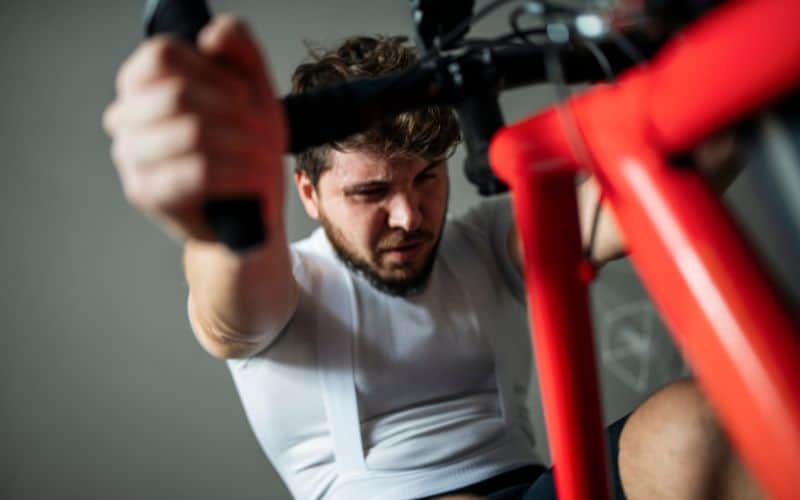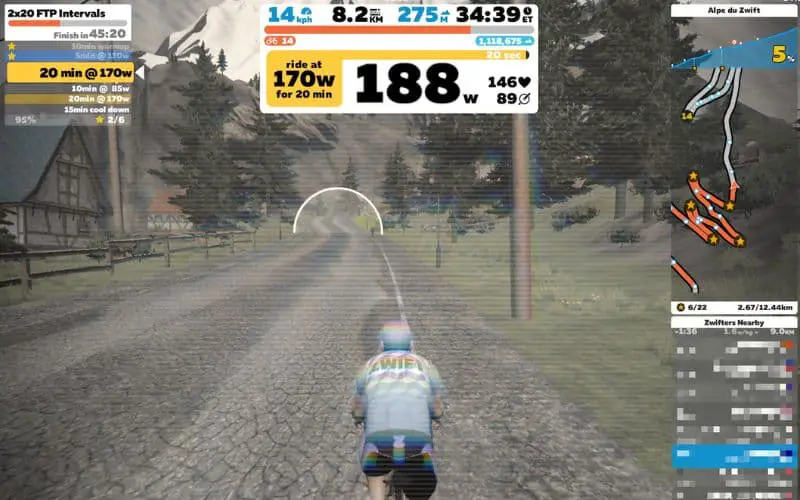I once believed outdoor cycling was the pinnacle of difficulty. That was until I tried Zwift.
In my journey, I discovered Zwift’s unique challenges. The constant pedal-turning, with no coasting or natural breaks, intensified my workouts. Indoors, the environment is static, lacking natural elements like wind or changing terrain. Zwift’s virtual world demands constant attention and effort, making each ride a new challenge.
You’ll understand why Zwift can feel tougher than outdoor rides.

Understanding Zwift and Indoor Cycling
Zwift, the popular indoor cycling app, partners with smart trainers to create a realistic virtual experience offering a variety of workouts, races, and customizable routes. Many users find it to be more challenging than cycling outdoors.
When using a smart trainer, the controlled environment can make riding on Zwift feel tougher. This change can be attributed primarily to three factors: body cooling, motivation, and resistance.
Body Cooling
Firstly, when training indoors, your body will become less efficient at cooling.
When cycling outdoors, the wind blowing at you helps dissipate heat. That’s not the case with Zwift. Ensure you crank up the fan in your training area to mimic the outdoor sensation and help regulate your body temperature.
Motivation
One aspect that Zwift can’t replicate is the motivation gained from feeling the wind in your hair and the road moving underneath you while cycling outside. This lack of real-world stimuli may affect your motivation and make your workout feel harder than anticipated.
In addition, Zwift races are sometimes considered harder than real-life races. The competition is fierce, and every ride can feel like a time trial. You may constantly push your limits, making the experience more challenging than casual outdoor rides!
Trainer Resistance
Trainer resistance presents another challenge. Your smart trainer provides controlled resistance to mimic various terrains and efforts. Sometimes, this resistance can feel more difficult to overcome than the natural resistance encountered outdoors.
Gears and cadence are crucial for maintaining smooth pedal strokes when facing different resistance levels. Adjusting your gears and maintaining a consistent cadence can help you adapt to the varied challenges of indoor training.
Comparison: Zwift vs Real-world Cycling
Weather Influence
When riding on Zwift, it’s easy to forget that weather conditions can significantly impact your ride outside.
In the real world, you’ll need to deal with wind resistance — headwinds slowing you down and tailwinds helping you maintain speed. Additionally, rain, snow, and fluctuating temperatures affect your experience outdoors, whereas riding on Zwift lets you avoid these weather-related challenges altogether.
While Zwift has some weather aspects, like the avatars wearing warmer clothes in colder environments, it cannot replicate the full range of weather conditions experienced in outdoor riding!

Traffic and Safety Factors
One aspect of real-world cycling that Zwift can’t capture is traffic and safety concerns.
In Zwift, you’ll encounter other riders on your virtual course, but you won’t need to worry about vehicles, pedestrians, stop signs, or other outdoor hazards.
Outdoor riding requires constant vigilance, with the need to be aware of potential dangers and exercise precaution at every turn. Riding on Zwift lets you focus on the ride, free from the worries of traffic and safety.
However, this also means that Zwift doesn’t provide the same level of bike handling practice and real-world experience as outdoor riding.
Terrain Differences
In the Zwift environment, you’ll find simulated gradients and terrains that do their best to imitate the real-world experience of outdoor riding.
However, the physical sensation will not precisely match riding outdoors. For instance, when climbing hills, Zwift adjusts the resistance on your trainer to mimic the gradient, but your bike remains stationary, lacking the need for dynamic bike handling.
On the other hand, when you ride outdoors, you’ll experience the real sensation of ascending and descending hills, which requires constant adjustments in your body position and exertion.
While Zwift may sometimes seem harder, it’s still an excellent training tool. The platform provides a controlled environment to measure your progress, adhere to your training plan, and improve your overall cycling performance.
Frequently Asked Questions
Why do I feel more resistance on Zwift compared to outdoor cycling?
This is a common observation. The resistance you feel on Zwift is a simulated version of real-world cycling resistance, factoring in elements like virtual terrain and draft.
However, it can sometimes feel harder because it lacks real-world variables like wind resistance, road texture, and momentum. Your indoor trainer’s calibration and Zwift’s resistance settings can also significantly influence this perceived difference.
Is there a difference in heart rate between indoor and outdoor cycling?
Yes, many cyclists notice a difference in heart rate between indoor and outdoor rides. Indoor cycling, especially on platforms like Zwift, often results in a higher heart rate.
This can be due to several factors like room temperature, lack of air movement, constant pedal turning (no coasting or stopping as outdoors), and mental engagement levels.
Can the trainer difficulty setting on Zwift influence the perceived effort?
Absolutely. The trainer difficulty setting in Zwift adjusts how road gradients are simulated by your trainer. A higher setting means you’ll feel more resistance on climbs, making the effort more realistic than outdoor hills!
Adjusting this setting can help align your indoor experience closer to your outdoor riding style and effort levels.

